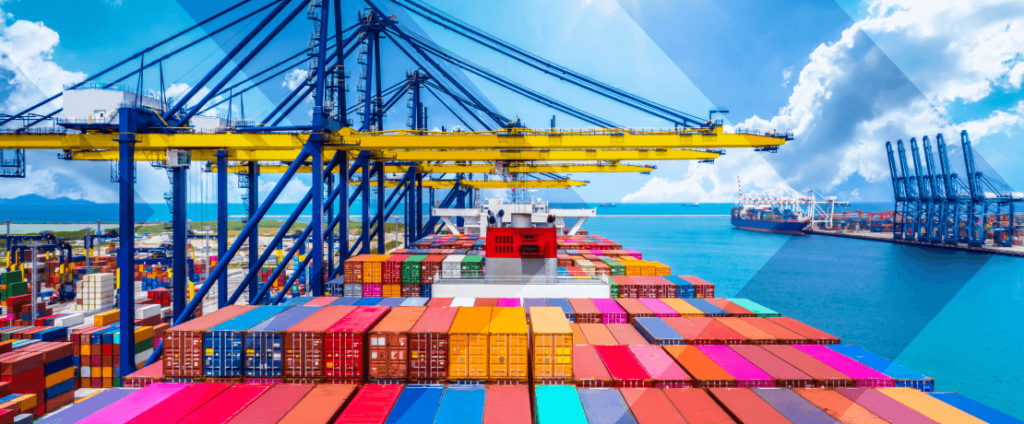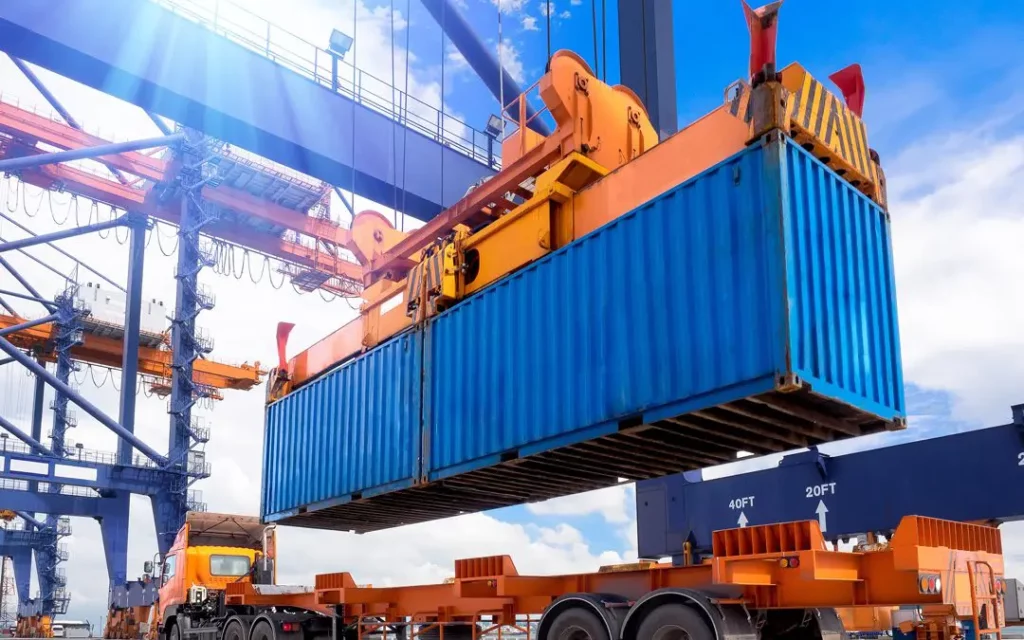Modern commerce can often feel like a complex puzzle, with countless interconnected pieces, each playing a vital role in the bigger picture of successful business operations.
Drayage, an often overlooked element, is indispensable for efficient transportation , playing a pivotal role in the seamless flow of goods from point to point.
Drayage rates and fees represent the costs associated with this localized transportation leg in the supply chain. Typically, this involves moving containers from the port to nearby destinations, such as warehouses or distribution centers.
These fees can be significant cost factors for businesses engaged in importing and exporting , and understanding them is not just an option – it’s a necessity.
This article will help to clarify drayage rates and fees, equipping businesses with the knowledge and insights they need to make informed decisions about their shipping expenses. We’ll shed light on the factors that drive costs, the various fees involved, and strategies for cost reduction.

Understanding Drayage
Factors Affecting Drayage Rates
Drayage rates are not set in stone, they can vary based on several factors.
For businesses, efficient container drayage means shorter lead times, lower inventory costs, and ultimately, happier customers.
Understanding what influences these rates is vital to making informed shipping decisions.
How Drayage Rates Are Calculated
First things first, let’s look at some common factors that impact drayage fees:
- Distance: The length of the journey from the port to the final destination plays a big role. Longer distances often mean higher rates.
- Time of Delivery: When you want your goods delivered matters. Some time slots might be busier or more convenient than others, affecting the cost.
- Drop and Hook vs Live Unload: Almost all time utilizing the “house” carrier or a dedicated carrier who operates their own assets and is willing to drop and hook your containers makes it more efficient for the receiving warehouse to stage and unload containers at their convenience. If you are required to have your container “live unloaded” this can often lead to longer unloading times and additional carrier fees.
- Ease of Handling: The type of goods you’re moving makes a difference. If your cargo is easy to handle, such as palletized freight, it can be more efficient and thus less expensive. Floor loaded containers or any irregular commodities requiring specialized handling or equipment, can likely drive up the cost.
- Carrier Type: Most every carrier has their own proprietary rating process. It is important whenever possible to select an asset based carrier, someone who owns their own truck capacity, to insure service reliability. Often times you may also need an “asset light” or brokered solution to augment your carrier pool to insure coverage and avoid port related penalties.
- Weight: Each container depending upon its size has an allowable Maximum Gross Weight. While it is imperative to the importer / exporter to maximize the containers capacity to driver your lowest cost, it is equally imperative to understand the leag weight limits for haulage between the port and your final destination. .
- Special Handling: If your goods need special care, such as temperature control, heavy weight hauling, in-bond transit or any other services, these will often come at an extra cost.
All these factors come together to determine the base fee for your drayage.
But it doesn’t stop there. Drayage costs can even be influenced by economic and regional factors, seasonal and market trends, or they can be calculated differently depending on the carrier and your relationship with them.
Accessorial charges can also sneak into the picture. These are extra fees for services outside the usual routine, like waiting time, special handling, or equipment use. As you can see, there’s a lot to consider when it comes to drayage rates and companies are not always forthcoming about the fees you might incur.
Types of Drayage Fees
Key Charges to Be Aware Of
When it comes to drayage, understanding the various fees involved is crucial. Here are the key charges that every business should be aware of:
- Base Drayage Fee: This is the fundamental charge for moving your goods from the port to their destination, the “linehaul” element. It’s determined by factors listed above, like distance, delivery time, and ease of handling.
- Accessorial Charges: These are additional fees for services outside the usual procedures. They can include fuel surcharges, tolls, waiting time, special handling, or equipment usage. Being aware of these charges can help you manage costs effectively.
- Detention Fees: Carriers usually allow a specific “free time” period for recovering your container that the port, as well as while waiting for it to be unloaded at your warehouse. Any time spent waiting beyond this free time can incur detention fees, which typically range from $75 to $150 per hour. It’s essential to monitor and manage detention time to avoid these costs.
- Demurrage Fees: If your cargo remains at the port or terminal longer than the allotted time, you may face demurrage fees. These fees vary by Port and can add up very quickly. Proper scheduling and coordination can help prevent demurrage charges.
Equipment, Port, Detention, and Demurrage Fees
In addition to the key charges, there are specific fees associated with equipment, port operations, detention, and demurrage:
- Equipment Fees: These charges can vary based on whether the freight company uses its own chassis or one provided by the port or a “pool chassis.” They may come as pass-through costs, or an administrative fee may apply if coordination is needed.
- Fuel Charges: Expect a fuel charge, typically calculated as a percentage of the linehaul rate.
- Port Fees: Depending on the specific ocean terminal, there could be associated fees. Factors like congestion, appointment scheduling and local tolls can influence these charges, as can the necessity to use a particular terminal over others.
- Overweight Fees: Containers exceeding the legal weight limit can incur overweight fees, which might include obtaining special permits.
- Tolls: If tolls are assessed along the route, they will be passed on to the shipper. Additional administrative fees might also apply.
- Other Fees: Several other charges can add up, such as:
- Drop Fees: If a carrier has to leave a container at its destination and return later due to the inability to load the freight immediately.
- Pre-pull Fees: When a container is pulled from the terminal to prevent demurrage and then staged for later delivery, there’s an additional drayage rate to move it from the staging area to the final destination.
- Chassis Split Fees: If a trucker has to travel to another location due to the terminal lacking a chassis, a chassis split fee could be charged to cover the extra time and mileage
- Container Diversion Fee: If a trucker is required to return your container to a location other than the port of origination, a container diversion fee could be charged.
All these charges, when considered together, can accumulate substantially. By understanding and managing these fees, businesses can effectively control their drayage expenses.

Reducing Drayage Expenses:
Cost-Saving Strategies
Drayage expenses can add up, but there are several strategies to help businesses manage and reduce these costs effectively:
- Ship Efficiently: The fewer touches needed to move your container, the better. Be flexible with your pick-up and drop-off dates to minimize extra steps, and wheneven possible given regular daily activity allow the carrier to simply drop and hook. Knowing port volume, equipment availability, and shipment timelines can help you optimize your scheduling and reduce additional charges.
- Optimize Packaging: Be mindful of how your goods are packaged. Preferably ship palletized freight that can be more efficiently secured within the container and unload with minimal labor helps to minimize your cost.
- Focus on Service: Reliability should be heavily considered in your selection process to insure that your carrier can meet your expectations each and every day, especially during peak times. s.
Negotiating Better Drayage Rates
Negotiating drayage rates can be an effective way to control costs. Here are some tips for successful rate negotiations:
- Volume Forecasts: Provide as much visibility to your carrier as possible, including any seasonality your might have to insure pricing accusracy.
- Long-Term Contracts: Establishing long-term contracts with carriers can lead to better rates and rate stability. It provides carriers with a predictable flow of business, and in return, they may offer you more competitive pricing.
- Leverage Competitive Bidding: Don’t be afraid to seek quotes from multiple carriers and use competitive bidding to your advantage. It can help you identify the best rates available in the market. But don’t make your decision exclusively on rate as there is always a lower rate out there.
Efficiency in Supply Chain Management
Improving the overall efficiency of your supply chain can indirectly lead to drayage cost reduction. Consider the following approaches:
- Optimize Routing: Insure your provider is technology savy and leveraging the tools of today to plan efficient routes and minimize miles traveled. Reducing the distance your goods need to travel can save both time and money.
- Real-Time Tracking: Implement real-time tracking solutions to monitor the movement of your cargo. This helps in reducing waiting times and detention fees.
- Inventory Management: Streamline your inventory management processes to reduce the need for expedited shipping. Having the right inventory in the right place at the right time can prevent costly stock-outs.
Partnering with a Full-Service 3PL Company
One valuable strategy for reducing drayage costs is to partner with an integrated third-party logistics (3PL) provider. A 3PL company has extensive experience and expertise in managing drayage and can offer various benefits:
- Access to a network of carriers and resources for more competitive rates.
- Efficient management of the entire logistics process, from pickup to delivery.
- Expertise in navigating complex drayage regulations and requirements.
- Technology solutions for route optimization and real-time tracking.
- Localized, custom solutions to meet your specific supply chain needs.
What truly sets integrated 3PL providers apart is their seamless handling of not only drayage but also warehousing and final-mile delivery.
Integrated 3PL providers assume full ownership of the entire process, eliminating any uncertainties. In doing so, they offer you a single point of contact, giving you control and visibility over a substantial portion of your supply chain. A one-stop shop solution!
This integrated approach further means that any after-hours requirements or last-minute adjustments can be handled seamlessly. Whether it involves receiving an incoming container or swiftly accommodating an urgent outbound shipment for a retailer, your integrated 3PL is in control of every aspect of the distribution process.
Taking Control of Drayage Costs:
Your Roadmap to Success
Informed decision-making is your key to mastering drayage rates and optimizing your supply chain. By understanding the intricacies of this vital logistics component, you are better positioned to navigate the complexities of modern commerce and enhance the efficiency of your business operations.
Let’s sum up the key takeaways:
- Drayage rates are influenced by factors like distance, time, handling, weight, and special services.
- Accessorial charges, including detention and demurrage fees, can quickly add to your expenses.
- Economic, regional, seasonal, and market factors affect drayage rates, making it important to adapt to changing conditions.
Armed with this knowledge, you can take proactive steps to reduce your drayage costs:
- Optimize container packaging efforts to maximize efficiency.
- Negotiate better drayage rates through volume forecasts and long-term contracts.
- Embrace supply chain management practices that enhance efficiency and reduce waiting times.
- Strongly consider Service Reliability and not simply the lowest cost.
For those seeking a comprehensive solution, partnering with a full-service 3PL company can be a game-changer. These experts offer access to carrier networks, route optimization, real-time tracking, and tailored solutions to drive down costs while ensuring the seamless flow of your goods.
With these insights and strategies at your disposal, you can confidently assume control over your drayage costs and pave the way for increased success in the realm of shipping and logistics.
